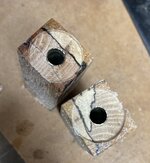Gary Beasley
Member
I cut some blanks from a nicely spalted piece of pecan the other day and decided to harden them up a bit with Varathane Wood Hardener. I put the pieces into a jar and pour a couple of inches of hardener into the jar and put the lid on. After shaking it a bit to wet the wood I left it sit for a day to wick the solution in to the wood. Halfway through I took them out and put them back in the other end up to ensure evenness.
I was quite surprised when I took the out to dry today to find streaks of blue coming out of the spalting. There must have been something in the fungal byproducts that had dye qualities to it.

I was quite surprised when I took the out to dry today to find streaks of blue coming out of the spalting. There must have been something in the fungal byproducts that had dye qualities to it.


